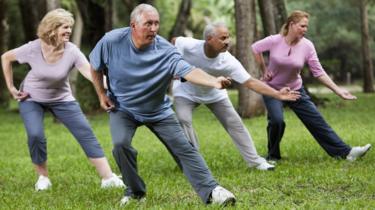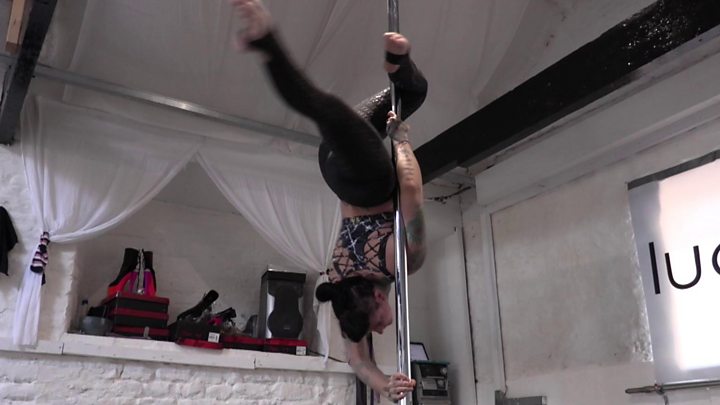
Tai chi is as good as – or even better than – aerobic exercise for aiding people with the chronic pain condition fibromyalgia, a study has suggested.
The US trial of 226 adults with the condition showed that those who practised the martial art improved significantly more than those doing aerobic exercise over a 24-week period.
Its low-impact movements mean people of any age or fitness level can take part.
Aerobic exercise is currently a standard treatment for the condition.
But some patients find it hard to do because their symptoms keep changing.
Fibromyalgia is a long-term condition that causes pain all over the body and can also lead to increased sensitivity to pain, fatigue, muscle stiffness, memory problems and sleeping difficulties.
Aerobic exercises such as walking, cycling and swimming, together with resistance and strengthening exercises, like lifting weights, are recommended to help people who have been diagnosed.
But this study, published in the British Medical Journal, says the findings suggest “it may be time to rethink what type of exercise is most effective for patients”.
“Tai chi mind-body treatment results in similar or greater improvement in symptoms than aerobic exercise, the current most commonly prescribed non-drug treatment,” the authors said.
“This mind-body approach may be considered a therapeutic option in the multi-disciplinary management of fibromyalgia.”
- Tai Chi study ‘could help people with dementia’
- Lady Gaga halts tour due to ‘severe pain’
- How I’ve learned to live in constant pain
The adults taking part in the study had not participated in tai chi or other similar types of complementary and alternative medicine in the previous six months.
Their average age was 52 they had suffered body pain for an average of nine years and 92% of participants were women, with 61% being white.
They were each randomly assigned to either supervised aerobic exercise twice a week for 24 weeks or to one of four supervised tai chi sessions of 12 or 24 weeks, completed once or twice each week.
Changes in their symptom scores were assessed at 12, 24 and 52 weeks and participants continued taking their regular medicines and made their usual visits to their doctors.

Before embarking on the trial, members of the group had to fill in a questionnaire, scoring symptoms like pain intensity, physical function, fatigue, depression, anxiety and overall wellbeing.
While scores improved in all areas, the combined tai chi patients showed significant improvement at the 24-week stage, although there was little difference whether they did it once or twice a week.
The effects of tai chi were consistent across all the instructors and nobody suffered any serious adverse effects.
The researchers did say there were some limitations in their study – participants were aware of their treatment group assignment and attendance at sessions differed between the two forms of exercise.
However, they said that key strengths of their research were that it featured a large and diverse sample of people and had a longer follow-up than previous studies.
A guide to tai chi
- Tai chi combines deep breathing and relaxation with flowing movements
- Studies have shown that it helps people aged 65 and over to reduce stress, improve posture, balance and mobility and increase leg muscle strength
- Some research shows it can reduce the risk of falls
- There is some evidence it can improve mobility in the ankle, hip and knee in people with rheumatoid arthritis
- Nobody is too old or unfit to take up tai chi
- Tai chi is characterised by its slow, graceful, continuous movements – many of which are completed with bent knees in a squat-like position
The findings of the study have come as no surprise to some experts.
Mark Peters, a senior tai chi instructor and executive committee member of the Tai Chi Union for Great Britain, told the BBC: “It is a low-impact exercise and movements are steady and circular, and in terms of physical rehab at a hospital, it is a graded exercise – meaning it builds up progressively as ability builds up.
“Aerobics is high-impact but tai chi also increases heart rate and core strength, only with no impact problems.
“The NHS are big advocates and I’ve been teaching tai chi for patient rehab to NHS staff for 10-to-15 years or more and run courses like how to use it for brain injury and stroke recovery. I’ve been involved in quite a lot of studies which show it helps rebuild brain pathways.”
You may also be interested in:
Des Quinn, chairman of the Fibromyalgia Association, told the BBC: “It is no surprise to us that tai chi can be of help to people with fibromyalgia.
“There have been some pilot studies in the past that have suggested that it could benefit people with fibro. Its gentle approach to increasing activity is something that would be easier for sufferers than running, for example.
“However, what works for one person will not necessarily work for another in the same way. Someone with fibromyalgia faces a journey to find a balance of treatments and changes that improves their own quality of life.
“Increasing levels of activity is what we would tend to say when talking about exercise.”
https://www.bbc.com/news/health-43485851
更多帖子
- 有证据建议太极可以用来抵御心肌梗死 (强烈推荐)
- 太极使大脑变大,在中国老人控制试验下证明有益于认知能力 (强烈推荐)
- 卫平在美国讲老年健康 (强烈推荐)
- 陈中华弟子约翰・俄普芍在美国论坛讲太极的心里疗效 (强烈推荐)
 :18963387833
:18963387833